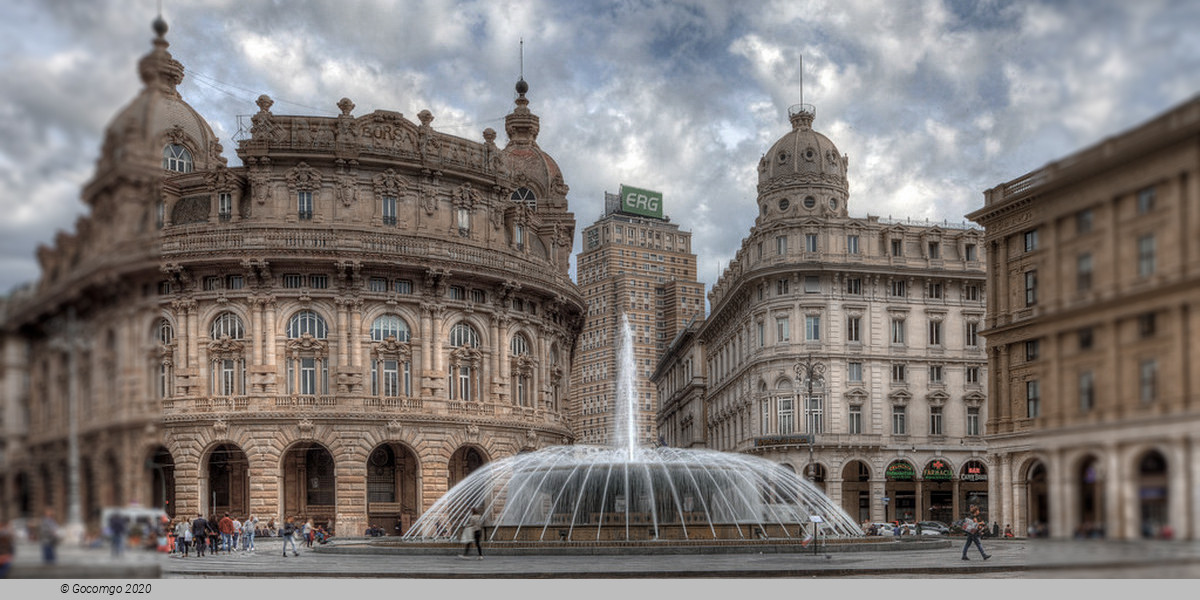Genova

Genoa is the capital of the Italian region of Liguria and the sixth-largest city in Italy. In 2015, 594,733 people lived within the city's administrative limits. As of the 2011 Italian census, the Province of Genoa, which in 2015 became the Metropolitan City of Genoa, had 855,834 resident persons. Over 1.5 million people live in the wider metropolitan area stretching along the Italian Riviera.
History
The city's area has been inhabited since the fifth or fourth millennium BC, making it one of the oldest continuously inhabited cities in the world. In the 5th century BC the first town, or oppidum, was founded at the top of the hill today called Castello (Castle), which is now inside the medieval old town. Among the ancient inhabitants of the region were the Ligures, that gave the name to the modern Liguria.
Genoa is a port city by birth, establishing itself as the merchant capital of the newly established Republic of Genoa in the 11th century and maintaining its independence until 1797. The republic was one of the states known as Repubbliche Marinare along with Venice, Pisa, and Amalfi. Trade, shipbuilding, and banking helped support one of the largest and most powerful navies in the Mediterranean. There is an old saying that says: Genuensis ergo mercator, or "A Genoese therefore a merchant" but the Genoese were skilled sailors and ferocious warriors in addition (see also the Genoese crossbowmen).
Throughout its existence the Republic had different forms of government, the most notable of these was the Dogate, that in actuality, was an oligarchy ruled by a group of wealthy merchant families, from whom the doges were selected. Internal feuds between the powerful families, such as the Grimaldi, the Fieschi, the Doria, the Spinola and others, caused much disruption, but in general the republic was run much as a business affair.
During the Late Middle Ages Genoa was one of the main commercial powers of the Mediterranean Sea, while between the 16th and 17th centuries it was one of the major financial centers in Europe.
The Genoese have a claim to the creation of the rough denim cloth then called "Blue Jeans" (an anglicised spelling of Gênes, the French name of the city), nowadays shortened simply as jeans, used by sailors for work and to cover and protect their goods on the docks from the weather. During the Republic of Genoa, Genoese merchants and sailors exported this cloth throughout Europe. The production of Genoese lace was also notable.
The earliest known state deposit bank, Banco di San Giorgio (Bank of St. George), was founded in 1407 in Genoa.
Through Genoese participation in the Crusades, colonies were established in the Middle East, Northern Africa and across the Mediterranean. Genoese Crusaders brought home a green glass goblet from the Levant, which the Genoese have long regarded as the Holy Grail. In his Golden Legend, the Archbishop of Genoa, Jacobus de Voragine relates the history of the Holy Grail. The Holy Chalice is now kept in the Genoa Cathedral.
During its rise and its apogee, the Republic of Genoa founded colonies in many parts of the Mediterranean and Black Sea, nicknamed "la Dominante dei mari" ("the Dominant of the Seas"), leaving valuable architectural works in many locations, and also extending its direct domain in numerous territories, including Corsica (now in France), Tabarka (now in Tunisia), Chios, Samos and Mytilene (now in Greece), Gibelet (now in Lebanon), Giurgiu, Galați and Calafat (now in Romania), and Southern Crimea.
Many aristocratic Genoese families, such as the Balbi, Doria, Grimaldi, Pallavicini and Serra, amassed tremendous fortunes. According to Felipe Fernandez-Armesto and others, the practices Genoa developed in the Mediterranean (such as chattel slavery) were crucial in the exploration and exploitation of the New World.
Thereafter, Genovese bankers, financed many of the Spanish crown's foreign endeavors. Fernand Braudel has even called the period 1557 to 1627 the "age of the Genovese", "of a rule that was so discreet and sophisticated that historians for a long time failed to notice it".
At the time of Genoa's zenith, the city attracted many artists including Rubens, Caravaggio and Van Dyck. The famed architect Galeazzo Alessi (1512–1572) designed many of the city's splendid palazzi, and Bartolomeo Bianco (1590–1657) designed the centrepieces of the University of Genoa. A number of Genoese Baroque and Rococo artists settled elsewhere and a number of local artists became prominent. In the late sixteenth century, Luca Cambiaso, known as the founder of the Genoese School of painting, went on to earn the largest payment then recorded (2,000 ducats) for work for Philip II of Spain in the Escorial palace in Madrid.
However, with the shift in world economy and trade routes to the New World and away from the Mediterranean, adding to the loss of several of its colonies, Genoa's political and economic power began a steady decline.
It was 1796 that the Republic of Genoa finally ended, replaced by Napoleonic ruled Ligurian Republic. Since 1815 after the "Congresso di Vienna" Genoa was annexed to the Regno di Sardegna (Sardinia Kingdom).
In the 19th and the early 20th centuries, Genoa consolidated its role as a major seaport and an important steel and shipbuilding centre. In Genoa in 1853, Giovanni Ansaldo founded Gio. Ansaldo & C. whose shipyards would build some of the most beautiful ships in the world, such as ARA Garibaldi, SS Roma, MS Augustus, SS Rex, SS Andrea Doria, SS Cristoforo Colombo, MS Gripsholm, SS Leonardo da Vinci, SS Michelangelo, and SS SeaBreeze. In 1854, the ferry company Costa Crociere was founded in Genoa and then the Lloyd Italiano maritime insurance company. In 1861 the Registro Italiano Navale Italian register of shipping was created, and in 1879 the Yacht Club Italiano. The owner Raffaele Rubattino in 1881 was among the founders of the ferry company Navigazione Generale Italiana which then become the Italian Line.

